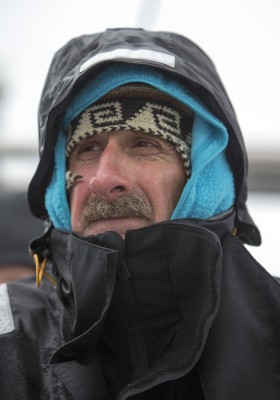It was probably the most ambitious project Yachting World has ever undertaken: to head for Cape Horn with high latitudes doyen Skip Novak to make a series on Storm Sailing Techniques. David Glenn reports from Tierra del Fuego
The ship’s bridge looked to be about 60ft above the waterline and the thought of how that happened sent a shiver down my spine. Yet here we were about to set off in search of heavy weather in the vicinity of Cape Horn aboard a 54ft yacht. Who in their right mind goes looking for such hostility?
The answer on this occasion was a team of four: me and Elaine Bunting from Yachting World, plus freelance cameraman Richard Langdon and marine surveyor Jonathan Reynolds representing Pantaenius Yacht Insurance, who were partnering us in our quest.
Our aim was to research, film and photograph a 12-part series about the sort of heavy weather seamanship most sane yachtsmen never want to put to the test, but knowledge of which is essential for anyone undertaking serious passagemaking.
To find all 12 parts of Skip Novak’s Storm Sailing Techniques series, click on the ‘Storm Sailing’ tag at the top of this page, or go to the end of the article for a list of topics.
In our experience, most sailors have a healthy appetite for authoritative advice on this subject, to say nothing of taking a vicarious interest in how others cope in extremis. It became our Storm Sailing Techniques series, written by Skip Novak and supported by video.
But this is the story of how we got the story.
We sail aboard Pelagic
The yacht we were using, Pelagic, is no ordinary yacht and Skip Novak, her owner and the man behind Pelagic Expeditions, no ordinary yachtsman. After a string of round the world races, including, at the age of 25, skippering King’s Legend to 2nd place in the 1977 Whitbread, then Simon Le Bon’s Drum in the punishing 1985/86 event followed by Fazisi, the Soviet entry in 1989, Skip combined his mountaineering and sailing skills to set up Pelagic Expeditions to take people on high-latitude adventures.
He has spent 24 seasons leading such expeditions, has become an authority on sailing and mountaineering in Antarctica and serves on the executive committee of the influential International Association of Antarctic Tour Operators (IAATO).
He launched the Patrick Banfield-designed Pelagic in the UK in 1987. This steel-built cutter with her lifting keel and rudder is a no-nonsense 30-ton yacht able to cope with ice abrasion and beaching. Skip describes Pelagic’s retractable appendages as her greatest asset: “Interesting for convenience, but ultimately important for safety. In polar regions her ability to get behind barrier rocks and moor to the shoreline in shallow water, makes her safe from drift ice and secure against high winds and seas.”
Her austral summer home port is Ushuaia in Tierra del Fuego in southern Argentina and during the winter she is moored in Stanley in the Falkland Islands. Her success led to the launch in 2003 of the 74ft ketch Pelagic Australis, an equally powerful aluminium vessel.
We first set eyes on Pelagic as she lay alongside a rickety jetty extending from the simple yacht club in Ushuaia. At 54.8°S Ushuaia is touted as the world’s most southerly city – the much smaller military settlements at Puerto Williams and Puerto Toro in Chile are, in fact, more southerly – and is ‘base camp’ for those heading for the Antarctic Peninsula 550 miles to the south and Cape Horn just 100 miles away.






